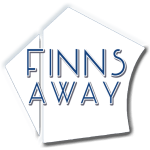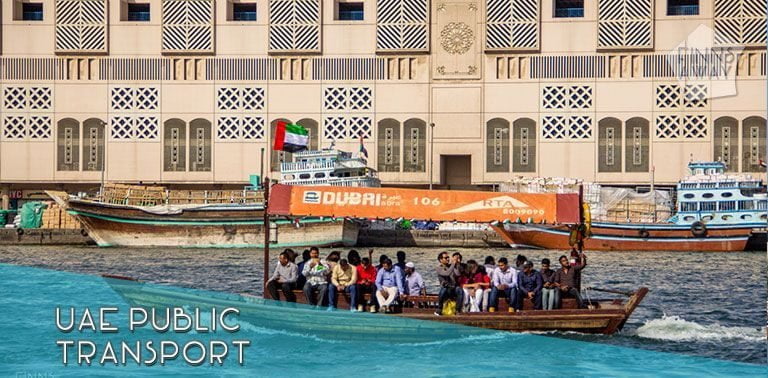
Public transport in and around Dubai
How to get around Dubai and United Arab Emirates overall? Many travel guides state that it’s not possible without private transportation and using taxi, but we’d say that travelers who don’t mind walking a few kilometers, are just fine with using public transport. However, if you’d like to explore destinations outside the city centers, options for public transport can be either very limited of nonexistent. In this short guide post we provide some information on how to get around central Dubai and Abu Dhabi, and how to move between the capital cities of different emirates. The price details in this post are in local currency AED, and the exchange rate is roughly 0,25 € / 1 AED, so one euro is around 4 Dirhams.
Public transport in Dubai
First of all, note that Dubai City is huge. When looking it in a map, it might not look that big, but what looks like a block in a map, often is a distance of around 1 km. For example, even if the metro line seems to run quite close to the coastline, most of the stations are several kilometers away from the beaches. Also, the footbridge called Metrolink, that leads from Burj Khalifa / Dubai Mall metro station to the mall itself, is 820 meters long! However, Dubai Metro is very useful for moving between the different parts of the city, and when you combine it with the extensive bus network and tram line, you can get pretty much everywhere in the city center.
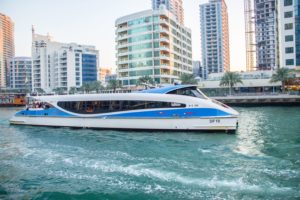
Dubai tram runs in Dubai Marina and along the coast in front of Palm Jumeirah Island, and is linked to two metro stations, as well as to the monorail to Palm Jumeirah. Yet another way of public transport are the small, wooden boats called abra (in the cover picture of this post), that take you cross the Dubai Creek between Deira and Bur Dubai. Cost of one abra ride is 1 AED. There are also (rather expensive) water bus and Dubai Ferry services for longer distances along the creek, and in Dubai Marina. The operator of public transportation is governmental Dubai Road and Transportation Authority, in short RTA. Their website is useful for finding information about transport services and route maps.
Relater post: Dazzled by Dubai
NOL card for getting around Dubai
To use public transport in Dubai, you need to buy a smart card called NOL. The same card can be used in metro, tram, bus and water bus lines, and also in intercity buses operated by RTA. NOL card tariff system in Dubai city is based on zones, and there are seven different zones all in all. You can use different modes of transportation during one journey, and the fare is taken from your card when you check out in the end of the trip, according to the total number of zones you have passed. It’s important to always remember to check out, otherwise the maximum amount for a single journey will be taken from the card.
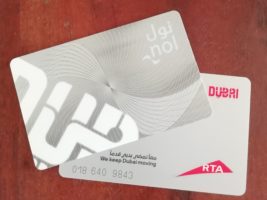
There are four different types of NOL cards, with a bit different pricing. The best option for tourists is the Silver Card, or for very short visits the Red Ticket. Red ticket is a paper card that costs only 2 AED, and can be loaded with up to 10 trips. However, it’s not re-loadable, and suitable only for one mode of transportation. It’s best choice when you are only on a short visit, and plan to use metro for only a couple of times. The other option is the smart Silver Card with e-purse, where you can load more value whenever you want. The card costs 25 AED, but includes 19 AED e-purse value, so the price of the card itself is 6 AED. Also, as the single journeys are cheaper compared to the Red Ticket, this card pays itself back quickly. RTA web pages have good instructions on how to buy and use NOL cards, and even a tool to compare them to find the best option for you.
Traveling between different emirates
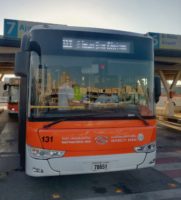
There are altogether seven different emirates in UEA, and some of them have their own transportation operators. NOL card can be used for intercity trips operated by RTA, so basically for the trips from Dubai to different emirates. We used NOL card for intercity bus from Dubai to the emirate of Fujairah and back, and to get from Ajman to Dubai. Intercity buses between Sharjah and Ajman, and north from there, are operated by a Sharjah RTA, and paper tickets to them can be bought in cash. Also the bus we used to get from Abu Dhabi to Sharjah was operated by SRTA, and paper tickets for it could be bought from the bus station. New Sayer smart card system has been taken in use in orange Mowasalat buses that operate in Sharjah emirate, but cash payments are still possible as well.
Fares for long distance bus routes are surprisingly affordable. We listed for a reference the intercity bus trips that we made in December 2018;
- Abu Dhabi (Central station) to Sharjah (Al Jubail): 30 AED (bus 117, paper ticket)
- Sharjah (Al Jubail) to Ajman (Central station): 5 AED (bus 112, paper ticket)
- Ajman to Dubai (Union Square): 15 AED (bus E400, with NOL card)
- Dubai (Union Square) to Fujairah (city center): 25 AED (bus E700, with NOL card)
- Dubai (Al Ghubaiba) to Abu Dhabi (Central station) : 25 AED (bus E100, with NOL card)
Related posts:
Exploring Sharjah and Ajman
Historical and tranquil Fujairah
Public transport in Abu Dhabi

There are no metro lines in Abu Dhabi, but an extensive bus network covers the whole Abu Dhabi city. To be able to use the buses, you’ll need a bus card called Hafilat. There are two card types suitable for tourists; a gray card for temporary use (5 AED, valid for 14 days) and a green card for more permanent use (10 AED, valid for 5 years). The first mentioned is recommended for short stays, but for some reason we were only able to buy permanent cards from the airport, or the ticket machines we used in the city center, so we bought green cards. In addition to the card, you’ll need to load some value on the card’s rechargeable “T-purse”. The fare for a single trip in Abu Dhabi city area is 2 AED, and from/to suburbs 2 AED + 0,05 per km. For example the trip from airport to central bus station cost 3,50 AED. Also in Abu Dhabi you need to read the card both in the beginning and the end of your journey.
Related post: From Abu Dhabi (airport) to Sharjah by bus
Practical info
As with many other things in UAE, there are a lot of rules when it comes to public transport. First of all, always respect the seating instructions. In metro trains there are marked carriages only for women and children traveling with them, and also in buses there are marked seating area for women. Women and families are respected also when it comes to buying tickets or queuing. There often are separate lines for women, and if not, then women and families can and should skip the queue to be served first. These rules seemed to apply also for couples without kids. All in all, behavior towards women was very respectful.
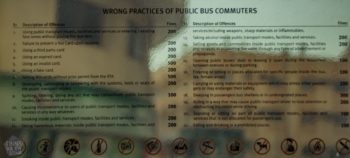
And then the rules. This picture of an instructions sign in a bus window tells quite much. According to it, pretty much everything, except just sitting tight and being quiet, seems to be forbidden in public transportation vehicles. Most of these rules are very obvious and part of normal behavior of course, but it’s somehow funny how they have defined fines for all 21 different violations in the list. Don’t worry too much about the rules, just take care that you pay for the ride, don’t sit in reserved seats and don’t eat during the trip, and you’ll be just fine.
Hopefully this small guide can be of help when you travel to UAE. Happy and safe travels!
